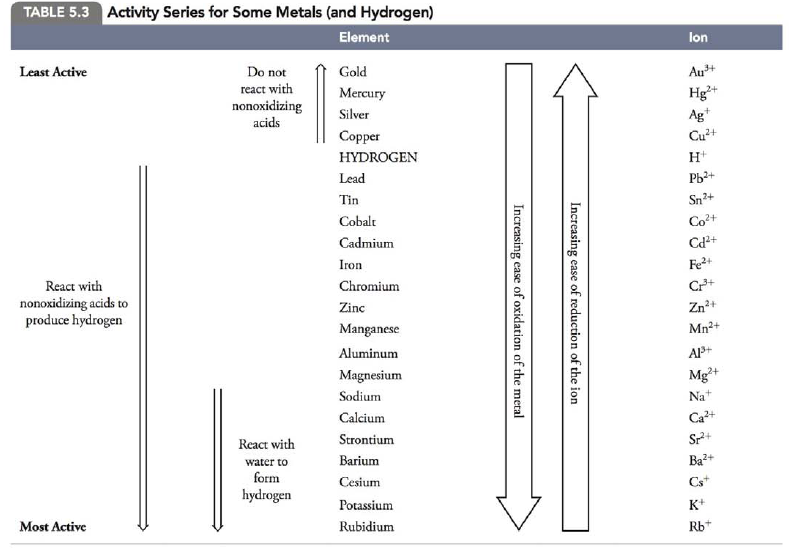
Use Table 5.3 to predict the outcome of the following reactions. If no reaction occurs, write N.R. If a reaction occurs, write a balanced chemical equation for it.

Want to see the full answer?
Check out a sample textbook solution
Chapter 5 Solutions
MOLECULAR NATURE OF MATTER 7/E LL W/AC
Additional Science Textbook Solutions
Organic Chemistry (8th Edition)
Campbell Biology (11th Edition)
Human Biology: Concepts and Current Issues (8th Edition)
Anatomy & Physiology (6th Edition)
Chemistry (7th Edition)
Chemistry: An Introduction to General, Organic, and Biological Chemistry (13th Edition)
- Write balanced net ionic equations for the following reactions in acid solution. (a) Liquid hydrazine reacts with an aqueous solution of sodium bromate. Nitrogen gas and bromide ions are formed. (b) Solid phosphorus (P4) reacts with an aqueous solution of nitrate to form nitrogen oxide gas and dihydrogen phosphate (H2PO4-) ions. (c) Aqueous solutions of potassium sulfite and potassium permanganate react. Sulfate and manganese(II) ions are formed.arrow_forwardWrite the net ionic equation for the reaction, if any, that occurs on mixing (a) solutions of sodium hydroxide and magnesium chloride. (b) solutions of sodium nitrate and magnesium bromide. (c) magnesium metal and a solution of hydrochloric acid to produce magnesium chloride and hydrogen. Magnesium metal reacting with HCl.arrow_forwardThe Ostwald process for the commercial production of nitric acid involves the Following three steps: 4NH3(g)+5O2(g)4NO(g)+6H2O(s)2NO(g)+O2(g)2NO2(g)3NO2(g)+H2O(l)2HNO3(aq)+NO(g) a. Which reaction in the Ostwald process are oxidation-reduction reactions? b. Identify each oxidizing agent and reducing agent.arrow_forward
- Use the terms oxidation, reduction, oxidizing agent, and reducing agent to explain the extraction of bromine from brines.arrow_forward4.22 Generally, an excess of O2 is needed for the reaction Sn+O2SnO2 . What is the minimum number of moles of oxygen required to oxidize 7.3 moles of tin?arrow_forwardOne of the few industrial-scale processes that produce organic compounds electrochemically is used by the Monsanto Company to produce1,4-dicyanobutane. The reduction reaction is 2CH2CHCH+2H++2eNC(CH2)4CN The NC(CH2)4CN is then chemically reduced using hydrogen gas to H2N(CH2)6NH2, which is used in the production of nylon. What current must be used to produce 150.kg NC(CH2)4CN per hour?arrow_forward
- Xenon trioxide, XeO3, reacts with aqueous base to form the xenate anion, HXeO4. This ion reacts further with OH to form the perxenate anion, XeO64, in the following reaction: 2HXeO4(aq)+2OH(aq)XeO64(aq)+Xe(g)+O2(g)+2H2O(l) Identify the elements that are oxidized and reduced in this reaction. You will note that the equation is balanced with respect to the number of atoms on either side. Verify that the redox part of this equation is also balanced, that is, that the extents of oxidation and reduction are also equal.arrow_forwardThe blood alcohol (C2H5OH) level can be determined by titrating a sample of blood plasma with an acidic potassium di-chromate solution, resulting in the production of Cr3+ (aq) and carbon dioxide. The reaction can be monitored because the dichromate ion (Cr2O72) is orange in solution, and the Cr3+ ion is green. The balanced equations is 16H+(aq) + 2Cr2O72(aq) + C2H5OH(aq) 4Cr4+(aq) + 2CO2(g) + 11H2O(l) This reaction is an oxidationreduction reaction. What species is reduced, and what species is oxidized? How many electrons are transferred in the balanced equation above?arrow_forwardA Describe how to prepare zinc chloride by (a) an add-base reaction, (b) a gas-forming reaction, and (c) an oxidation-reduction reaction. The available starting materials are ZnCO3, HCl, Cl2, HNO3, Zn(OH)2, NaCl, Zn(NO3)2, and Zn. Write complete, balanced equations for the reactions chosen.arrow_forward
- The iron content of hemoglobin is determined by destroying the hemoglobin molecule and producing small water-soluble ions and molecules. The iron in the aqueous solution is reduced to iron(II) ion and then titrated against potassium permanganate. In the titration, iron(ll) is oxidized to iron(III) and permanganate is reduced to manganese(II) ion. A 5.00-g sample of hemoglobin requires 32.3 mL of a 0.002100 M solution of potassium permanganate. The reaction with permanganate ion is MnO4(aq)+8H+(aq)+5Fe2+(aq)Mn2+(aq)+5Fe3+(aq)+4H2O What is the mass percent of iron in hemoglobin?arrow_forwardComplete and balance the equations of the following reactions, each of which could be used to remove hydrogen sulfide from natural gas: (a) Ca(OH)2(s)+H2S(g) (b) Na2CO3(aq)+H2S(g)arrow_forwardThe presence of arsenic in a sample that may also contain another Group 5A element, antimony, can be confirmed by first precipitating the As3+ and Sb3+ ions as yellow solid As2S3 and orange solid Sb2S3. If aqueous HCI is then added, only Sb2S3 dissolves, leaving behind solid As2S3. The As2S3 can then be dissolved using aqueous HNO3. 3 As2S3(s) + 10 HNO3(aq) + 4 H2O() 6 H3AsO4(aq) + 10 NO(g) + 9 S(s) Finally, the presence of arsenic is confirmed by adding AgNO3 to the solution of H3AsO4 to precipitate a reddish brown solid AgxAsOy The composition of this solid is As, 16.199% and Ag, 69.964%. (a) What are the oxidation numbers of As, S, and N in the reaction of As2S3 with nitric acid? (b) What is the formula of the reddish brown solid AgxAsOy?arrow_forward
 World of Chemistry, 3rd editionChemistryISBN:9781133109655Author:Steven S. Zumdahl, Susan L. Zumdahl, Donald J. DeCostePublisher:Brooks / Cole / Cengage LearningChemistry: Matter and ChangeChemistryISBN:9780078746376Author:Dinah Zike, Laurel Dingrando, Nicholas Hainen, Cheryl WistromPublisher:Glencoe/McGraw-Hill School Pub Co
World of Chemistry, 3rd editionChemistryISBN:9781133109655Author:Steven S. Zumdahl, Susan L. Zumdahl, Donald J. DeCostePublisher:Brooks / Cole / Cengage LearningChemistry: Matter and ChangeChemistryISBN:9780078746376Author:Dinah Zike, Laurel Dingrando, Nicholas Hainen, Cheryl WistromPublisher:Glencoe/McGraw-Hill School Pub Co Chemistry for Engineering StudentsChemistryISBN:9781337398909Author:Lawrence S. Brown, Tom HolmePublisher:Cengage Learning
Chemistry for Engineering StudentsChemistryISBN:9781337398909Author:Lawrence S. Brown, Tom HolmePublisher:Cengage Learning Chemistry by OpenStax (2015-05-04)ChemistryISBN:9781938168390Author:Klaus Theopold, Richard H Langley, Paul Flowers, William R. Robinson, Mark BlaserPublisher:OpenStax
Chemistry by OpenStax (2015-05-04)ChemistryISBN:9781938168390Author:Klaus Theopold, Richard H Langley, Paul Flowers, William R. Robinson, Mark BlaserPublisher:OpenStax Chemistry: The Molecular ScienceChemistryISBN:9781285199047Author:John W. Moore, Conrad L. StanitskiPublisher:Cengage Learning
Chemistry: The Molecular ScienceChemistryISBN:9781285199047Author:John W. Moore, Conrad L. StanitskiPublisher:Cengage Learning Principles of Modern ChemistryChemistryISBN:9781305079113Author:David W. Oxtoby, H. Pat Gillis, Laurie J. ButlerPublisher:Cengage Learning
Principles of Modern ChemistryChemistryISBN:9781305079113Author:David W. Oxtoby, H. Pat Gillis, Laurie J. ButlerPublisher:Cengage Learning





